History of Parliamentary constituencies and boundaries in Essex
The ceremonial county of Essex, which includes the unitary authorities of Southend-on-Sea and Thurrock, has returned 18 MPs to the UK Parliament since 2010.
As a result of the creation of Greater London under the London Government Act 1963, which came into effect on 1 April 1965, the boundaries of the historic/administrative county were significantly altered, with the south-western corner, representing a majority of its population and seats, being transferred to Greater London, forming the London Boroughs of Newham, Barking and Dagenham, Havering, Redbridge and Waltham Forest. This was reflected in the following redistribution of parliamentary seats which came into effect for the February 1974 general election and effectively reduced the county's representation from 26 to 12 MPs.
Number of seats
The table below shows the number of MPs representing Essex at each major redistribution of seats affecting the county.
| Current county | London area | ||||
|---|---|---|---|---|---|
| Year | County
seats1 |
Borough
seats1 |
County
seats1 |
Borough
seats1 |
Total |
| Prior to 1832 | 2 | 6 | Included in current
county |
8 | |
| 1832-1868 | 4 | 6 | 10 | ||
| 1868-1885 | 6 | 4 | 10 | ||
| 1885-1918 | 6 | 1 | 2 | 2 | 11 |
| 1918-1945 | 7 | 1 | 1 | 11 | 20 |
| 1945-1950 | 8 | 1 | 1 | 16 | 26 |
| 1950-1955 | 8 | 2 | 0 | 14 | 24 |
| 1955-1965 | 10 | 2 | 0 | 14 | 26 |
| 1965-1974 | 10 | 2 | Part of Greater
London |
12 | |
| 1974-1983 | 10 | 4 | 14 | ||
| 1983-1997 | 11 | 5 | 16 | ||
| 1997-2010 | 12 | 5 | 17 | ||
| 2010–present | 12 | 6 | 18 | ||
1Prior to 1950, seats were classified as County Divisions or Parliamentary Boroughs. Since 1950, they have been classified as County or Borough Constituencies.
Timeline
County seat Borough seat
Historic county (excluding Outer London area from 1885)
| Constituency | Prior to 1832 | 1832-1868 | 1868-1885 | 1885-1918 | 1918-1945 | 1945-1950 | 1950-1955 | 1955-1965 |
|---|---|---|---|---|---|---|---|---|
| Essex | 1290-1832 (2 MPs) | |||||||
| North Essex | 1832-1868 (2 MPs) | |||||||
| East Essex | 1868-1885 (2 MPs) | |||||||
| Harwich | 1604-1868 (2 MPs) | 1868-1885 | 1885--> | |||||
| Colchester | 1295-1885 (2 MPs) | 1885-1918 | 1918--> | |||||
| Maldon | 1332-1868 (2 MPs) | 1868-1885 | 1885--> | |||||
| West Essex | 1868-1885 (2 MPs) | |||||||
| Saffron Waldon | 1885--> | |||||||
| Chelmsford | 1885--> | |||||||
| Epping | 1885--> | |||||||
| Chigwell | 1955--> | |||||||
| South Essex | 1832-1885 (2 MPs) | |||||||
| South East Essex | 1885-1950 | 1955--> | ||||||
| Billericay | 1950--> | |||||||
| Southend-on-Sea | 1918-1950 | |||||||
| Southend West | 1950--> | |||||||
| Southend East | 1950--> | |||||||
| Thurrock | 1945--> | |||||||
Outer London area (from 1885)
| Constituency | 1885-1918 | 1918-1945 | 1945-1950 | 1950-1955 | 1955-1964 | 1964-1965 |
|---|---|---|---|---|---|---|
| Romford | 1885-1945 | 1945--> | ||||
| Hornchurch | 1945-1950 | 1950--> | ||||
| Dagenham | 1945-1950--> | |||||
| Barking | 1945--> | |||||
| East Ham North | 1918--> | |||||
| East Ham South | 1918--> | |||||
| Ilford | 1918-1945 | |||||
| Ilford North | 1945--> | |||||
| Ilford South | 1945--> | |||||
| Woodford | 1945-1964 | |||||
| Wanstead and Woodford | 1964--> | |||||
| Walthamstow | 1885-1918 | |||||
| Walthamstow East | 1918--> | |||||
| Walthamstow West | 1918--> | |||||
| Leyton East | 1918-1950 | |||||
| Leyton West | 1918-1950 | |||||
| Leyton | 1950--> | |||||
| West Ham North | 1885-1918 | 1950--> | ||||
| Stratford | 1918-1950 | |||||
| Upton | 1918-1950 | |||||
| West Ham South | 1885-1918 | 1950--> | ||||
| Plaistow | 1918-1950 | |||||
| Silvertown | 1918-1950 | |||||
Current ceremonial county
| Constituency | 1965-1974 | 1974-1983 | 1983-1997 | 1997-2010 | 2010-present |
|---|---|---|---|---|---|
| Harwich | <--2010 | ||||
| Clacton | 2010-present | ||||
| North Essex | 1997-2010 | ||||
| Harwich and North Essex | 2010-present | ||||
| Colchester | <--1983 | 1997-present | |||
| North Colchester | 1983-1997 | ||||
| South Colchester and Maldon | 1983-1997 | ||||
| Witham | 2010-present | ||||
| Maldon | <--1983 | 2010-present | |||
| Maldon and East Chelmsford | 1997-2010 | ||||
| Braintree | 1974-present | ||||
| Chelmsford | <--1997 | 2010-present | |||
| West Chelmsford | 1997-2010 | ||||
| Saffron Waldon | <--present | ||||
| Epping1 | <--1974 | ||||
| Harlow | 1974-present | ||||
| Chigwell | <--1974 | ||||
| Epping Forest | 1974-present | ||||
| Brentwood and Ongar | 1974-present | ||||
| Billericay | <--1974 | 1983-2010 | |||
| Basildon and Billericay | 2010-present | ||||
| Rochford | 1983-1997 | ||||
| Rayleigh | 1997-2010 | ||||
| Rayleigh and Wickford | 2010-present | ||||
| Southend East | <--1997 | ||||
| Rochford and Southend East | 1997-present | ||||
| Southend West | <--present | ||||
| South East Essex | <--1983 | ||||
| Castle Point | 1983-present | ||||
| Basildon | 1974-2010 | ||||
| South Basildon and East Thurrock | 2010-present | ||||
| Thurrock | <--1974 | 1974-present | |||
| Constituency | 1965-1974 | 1974-1983 | 1983-1997 | 1997-2010 | 2010-present |
1Epping contained the Municipal Borough of Chingford, which was incorporated into the London Borough of Waltham Forest in 1965. From 1974, this formed the basis of the new constituency of Chingford in Greater London.
Boundary reviews
| Prior to 1832 | Since 1290, the Parliamentary County of Essex, along with all other English Counties regardless of size or population, had elected 2 MPs (Knights of the Shire) to the House of Commons. The county also included three Parliamentary Boroughs, namely Colchester, Harwich and Maldon each returning 2 MPs (burgesses). | |
|---|---|---|
| 1832 | The Great Reform Act of 1832 radically changed the representation of the House of Commons, with the County being divided into the Northern and Southern Divisions, both returning 2 MPs. The Parliamentary Boroughs all retained their 2 MPs. | |
| 1868 | Under the Reform Act of 1867, the county was further divided. The Northern Division was abolished and redistributed to the East and West Divisions, with both also including areas transferred from the Southern Division. The representation of the Boroughs of Harwich and Maldon was reduced to 1 MP each, thereby maintaining the overall representation of the county at 10 MPs. | |
| 1885 | Under the Redistribution of Seats Act 1885,[1] the three 2-member county divisions were replaced by eight single-member constituencies, namely the North Eastern or Harwich Division (which absorbed the abolished Parliamentary Borough of Harwich), the Eastern or Maldon Division (which absorbed the abolished Parliamentary Borough of Maldon), the South Eastern Division, the Mid or Chelmsford Division, the Northern or Saffron Walden Division, the Western or Epping Division, the South Western or Walthamstow Division and the Southern or Romford Division.
The representation of the Borough of Colchester was reduced to 1 MP and West Ham was created as a new Parliamentary Borough, divided into North and South Divisions. |
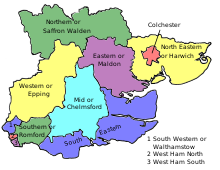 Essex 1885-1918 |
| 1918 | Under the Representation of the People Act 1918,[2] the number of constituencies in Essex was increased substantially to reflect the growth of the population since 1885 in the outer London area.
Outside the London area, the number of constituencies was only increased by one with the creation of the Parliamentary Borough of Southend-on-Sea which was carved out of South East Essex. The Parliamentary Borough of Colchester was converted into a county division, gaining western parts of Harwich. Other boundary changes included:
In the London area:
|
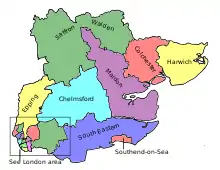 Essex 1918-1945 |
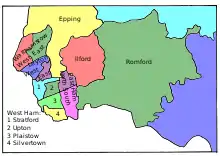 Outer London area of Essex 1918-1945 | ||
| 1945 | The House of Commons (Redistribution of Seats) Act 1944 set up Boundary Commissions to carry out periodic reviews of the distribution of parliamentary constituencies. It also authorised an initial review to subdivide abnormally large constituencies (those exceeding an electorate of 100,000) in time for the 1945 election.[3] This was implemented by the Redistribution of Seats Order 1945 under which Essex was allocated six additional seats:
The boundary between South East Essex and Chelmsford was redrawn to reflect the reorganisation of local authorities since 1918.[4] |
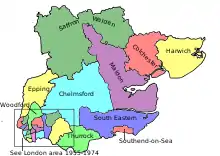 Essex 1945-1950 |
| 1950 | The Representation of the People Act 1948[5] reflected the reduction of population in the innermost parts of Outer London. West Ham's representation was reduced back down from four to two through the re-establishment of the North and South constituencies; and the two Leyton seats were combined to form the Leyton constituency.
Outside London, the expanded Borough of Southend was split between East and West constituencies, with the former including Shoeburyness and Rochford, both previously in South East Essex, which was now renamed Billericay. The only other significant change was the transfer of the Urban District of Brentwood from Chelmsford to Romford. |
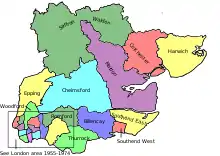 Essex 1950-1955 |
| 1955 | The First Periodic Review of Westminster constituencies resulted in the creation of Chigwell, primarily created from hiving off the Urban District of Chigwell from Woodford, but also including Chipping Ongar and surrounding rural areas, transferred from Chelmsford.
South East Essex was re-established, comprising the Urban Districts of Benfleet, Canvey Island and Rayleigh, which were previously included in the Billericay constituency, along with Rochford, transferred back from Southend East. Billericay now comprised the Urban District of Billericay (renamed Basildon Urban District shortly afterwards), along with that of Brentwood, transferred from Romford.[4] Following an interim review of boundaries in 1960, Woodford was renamed Wanstead and Woodford with only minor boundary changes. This came into effect for the 1964 general election. On 1 April 1965, the south-western corner of the county of Essex was incorporated into the new county of Greater London, resulting in the majority of the electorate and parliamentary constituencies being removed. As a result, the constituency of Epping was split between Essex and Greater London, with the area comprising the former Urban District of Chingford being included in the new London Borough of Waltham Forest. |
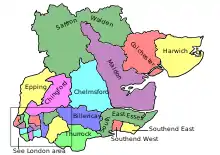 Essex 1955-1974 |
 Outer London area of Essex 1955-1965 | ||
| 1974 | The next national boundary change, following the recommendations of the Second Periodic Review,[6] reflected the change in county boundaries arising from the creation of Greater London in 1965, but did not come into effect for a further nine years at the February 1974 election. The impact on the constituencies within the re-constituted county of Essex was as follows:
Harwich, Colchester, Southend East, Southend West and Thurrock were unchanged. |
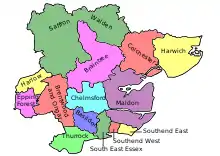 Essex 1974-1983 |
| 1983 | The Third Review[7] reflected the 1974 local government reorganisation arising from the Local Government Act 1972 and resulted in another significant redistribution, including the addition of two more seats. The main changes were as follows:
|
 Essex 1983-1997 |
| 1997 | The Fourth Review[8] saw another increase in the number of constituencies, with the creation the constituency of North Essex, which had significant knock-on effects as described below:
Elsewhere:
|
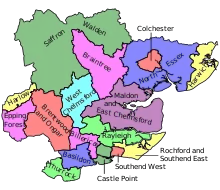 Essex 1997-2010 |
| 2010 | Under the Fifth Periodic Review of Westminster constituencies,[9] the Boundary Commission for England increased Essex's representation again, with the creation of the constituency of Witham. Approximately half of the new seat came from the Braintree constituency, including the town of Witham itself, with parts also transferred from Colchester, North Essex, and Maldon and East Chelmsford. Further boundary changes were as follows:
|
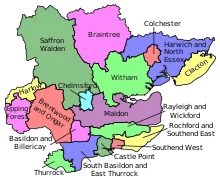 Essex 2010-present |
References
- Great Britain, Incorporated Council of Law Reporting for England and Wales. The public general acts. unknown library. Proprietors of the Law Journal Reports, 1884.
- Fraser, Hugh (1918). The Representation of the people act, 1918 : with explanatory notes. University of California Libraries. London : Sweet and Maxwell.
- Gay, Oonagh (2010-07-28). "The Rules for the Redistribution of Seats- history and reform".
- Craig, Fred W. S. (1972). Boundaries of parliamentary constituencies 1885-1972. Chichester: Political Reference Publications. ISBN 0-900178-09-4. OCLC 539011.
- "Representation of the People Act, 1948". www.legislation.gov.uk. Retrieved 2020-06-09.
- "The Parliamentary Constituencies (England) Order 1970". www.legislation.gov.uk. Retrieved 2020-06-11.
- "The Parliamentary Constituencies (England) Order 1983". www.legislation.gov.uk. Retrieved 2020-06-11.
- "The Parliamentary Constituencies (England) Order 1995". www.legislation.gov.uk. Retrieved 2020-06-11.
- "The Parliamentary Constituencies (England) Order 2007". www.legislation.gov.uk. Retrieved 2020-06-12.